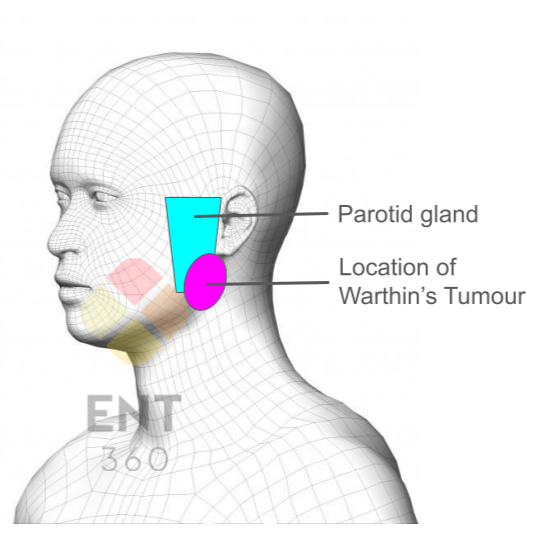Have you noticed a lump in your cheek or near your jawbone that doesn’t cause pain? It could be Warthin’s tumour, a benign (non-cancerous) growth in the parotid gland. This article will help you understand Warthin’s tumour, focusing on the diagnosis, treatment options, and what to expect if you have it.

Diagnosis: Identifying Warthin’s Tumour
While a painless lump might not seem like a significant concern, it’s always best to get it checked by a doctor. Here’s what you can expect:
- Physical Exam: Your doctor will feel the lump in your cheek to assess its size, location, and consistency.
- Fine-Needle Aspiration (FNA) Biopsy: This is the most common test for Warthin’s tumor. A thin needle is inserted into the lump to withdraw a small amount of tissue for examination under a microscope. This simple procedure usually confirms the diagnosis.
- Imaging Tests: Your doctor may sometimes recommend imaging tests like ultrasound, CT scan, or MRI. These tests can help clearer picture the tumour and surrounding tissues.
These diagnostic steps are relatively painless and straightforward.
Treatment Options: Addressing Warthin’s Tumor
The good news is that since Warthin’s tumour is benign, treatment isn’t always necessary. Here’s how your doctor will decide on the best course of action:
- Observation: If the tumour is small and not causing any problems, your doctor might recommend simply monitoring it with regular checkups. Observation is the most common approach for small, non-bothersome tumours.
- Surgery: If the tumour grows large enough to cause discomfort, facial distortion, or nerve or facial muscle damage, surgery might be recommended. It’s typically an outpatient procedure with minimal risks. Based on the size and location of the tumour, different surgical techniques are used. Discuss the various options with your doctor and take informed decision as to what is best for you.
What to Expect: Living with Warthin’s Tumor
Most people with Warthin’s tumour live normal, healthy lives. Here’s what you can expect:
- Regular Checkups: Even if you don’t require treatment, your doctor might recommend regular checkups to monitor the tumour’s growth.
- Peace of Mind: Knowing you have a benign tumour can be a relief. Remember, Warthin’s tumours are extremely unlikely to become cancerous.
Living with a lump can be unsettling, but understanding Warthin’s tumour and the available options can empower you to make informed decisions about your health. Don’t hesitate to discuss any concerns with your doctor.
This article was edited by Dr Akanksha Saxena, Consultant ENT, Head & Neck Surgeon, ENT360. She is a practising ENT Specialist in Gurgaon with over 10 years of experience. Read more of her blogs here.


